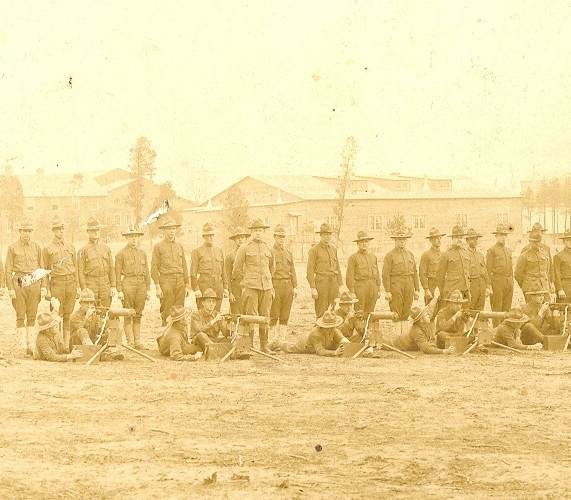History
This site addresses the semi-automatic Vickers and the Vickers' American roots. Richard Fisher in the U.K. has an excellent site about all other aspects of the Vickers' development and use. If the Vickers MMG is you general interest, please visit his site at http://www.vickersmachinegun.org.uk/.
A Brief History of the Semi-Automatic Belt-Fed
Since the US Congress passed the Firearms Owners' Protection Act of 1986, ownership of newly manufactured machine guns in the United States has been prohibited apart from some limited exceptions for government use and manufacturer's samples. The increase in collector demand has driven prices for the existing items well beyond the reach of most individuals. It's an example of the law of supply and demand since the supply of the commodity was fixed with the Firearms Owners' Protection Act and the demand continued to grow.
The belt fed semi-automatic phenomenon came about in the mid-1990s as a way to comply with the law while meeting collector interest in military weapons such as the RPD 7.62mm Light Machine Gun/Chinese Type-56 Light Machine Gun, M1910 Maxim, MG42, Vickers, M2 .50 caliber, M1917A1, and the 1919A4 -- just to name a few. In addition to the historical aspects of these military weapons, there are also collectors who are fascinated by the technical aspects of the evolution of the various types of arms. I consider myself one of the latter collectors. This reaction should be no surprise to our politicians; over 300 years ago the English philosopher John Locke argued that people will always find ways to legally circumvent an unpopular law. I can also point to the belt fed semi-automatic phenomenon as a classic example of the law of unintended consequences. The actions of government had the unanticipated effect of creating a market for the semi-automatic version of full-automatic military weapons that is much larger and less controlled than the pre-1986 market. Simply put, it created the demand, encouraged innovation, stimulated the manufacture, and overall vastly increased availability and ownership of belt fed guns like the 1919a4 and Vickers.
Mr. Curtis Debord of American Arms Delta pioneered the development of the semi-automatic Vickers. US Ordnance Reno, Nevada has commercially produced a semi-automatic version since approximately 1999. The US Ordnance Vickers is based on demiled (i.e., right side plate/receiver removed) Australian Lithgow Vickers .303 machine gun parts. Due to several large government orders for M60 series machine guns and spare parts, US Ordnance's Vickers production and sales were suspended.
The Vickers Has American Roots & Ties
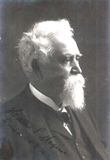 The Vickers gun has American roots being designed by Hiram Maxim, an American, born in Sangerville, Maine. Maxim was a prolific inventor developing and installing the first electric lights in a New York City building in the late 1870's. However, he was involved in several lengthy patent disputes with Thomas Edison over his claims to the light bulb. As a result of this dispute, Maxim emigrated to England in 1881 and became a naturalized Briton in 1899.
The Vickers gun has American roots being designed by Hiram Maxim, an American, born in Sangerville, Maine. Maxim was a prolific inventor developing and installing the first electric lights in a New York City building in the late 1870's. However, he was involved in several lengthy patent disputes with Thomas Edison over his claims to the light bulb. As a result of this dispute, Maxim emigrated to England in 1881 and became a naturalized Briton in 1899.
The US adopted Maxim's design as the first rifle caliber heavy machine gun for use as the standard service type by the U.S. Army in 1904. The first 90 guns and tripods were manufactured by Vickers, Sons & Maxim (VSM) in England in the U.S. caliber .30-03. Colt began production in 1908 when the service cartridge had changed from the .30-03 to the .30-06. Colt produced 197 guns, and with VSM's 90 guns, total production of the Model of 1904 was only 287 guns. Colt never produced any tripods. All the tripods were made by VSM and wheeled carriage mounts were produced by Rock Island Arsenal. The Model of 1904 saw a brief service life, being declared obsolete by 1915 with the adoption of the Vickers.
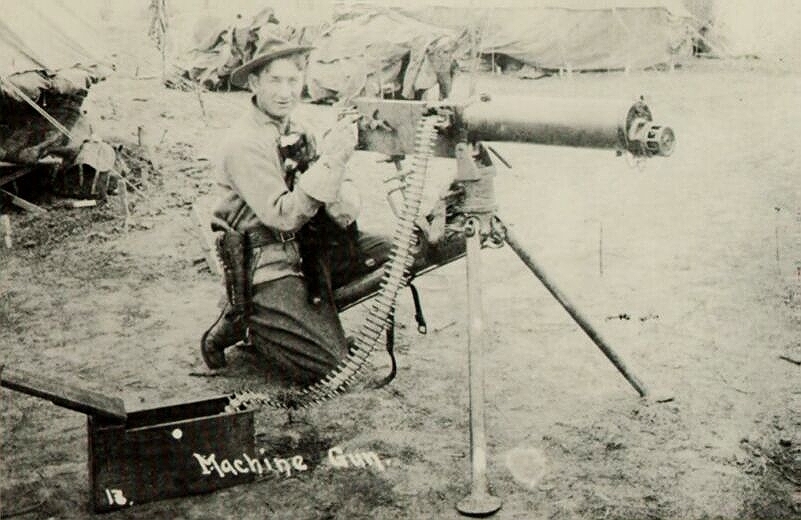
U.S. Maxim Automatic Machine Gun, Caliber .30, Model of 1904 (Picture used with permission from http://www.1919a4.com/forums/showthread.php?t=13727).
Hiram Maxim was invited to join the Vickers organization which established the Vickers, Sons and Maxim (VSM) company. Vickers redesigned the 40lb Maxim machine gun by lightening almost every component, inverting the lock and paring it down where possible to 28lbs. When comparing the Vickers parts to parts on other guns, you will notice the effort to keep the gun's weight down. For example, the image to the right is a comparison of the thickness of a Vickers outside side plate with the side plate of a 1919A4. The plate on the left is a side plate from a M1919A4 semi-automatic and the right is a side plate from a Vickers semi-automatic. The Vickers plate is significantly thinner since the inside side plates take the major portion of the force.
In 1913, the U.S. began to realize how short in supply of automatic weapons it was and started tests in 1913 and field trials in 1914. The Vickers was the clear the favorite. In 1915, the Board of Ordnance unanimously approved for the US Army the Model of 1915 chambered for the .30-06 cartridge. In 1915, they immediately placed an order for 125 guns to be made by Colt and in 1916 placed an additional order for 4,000.
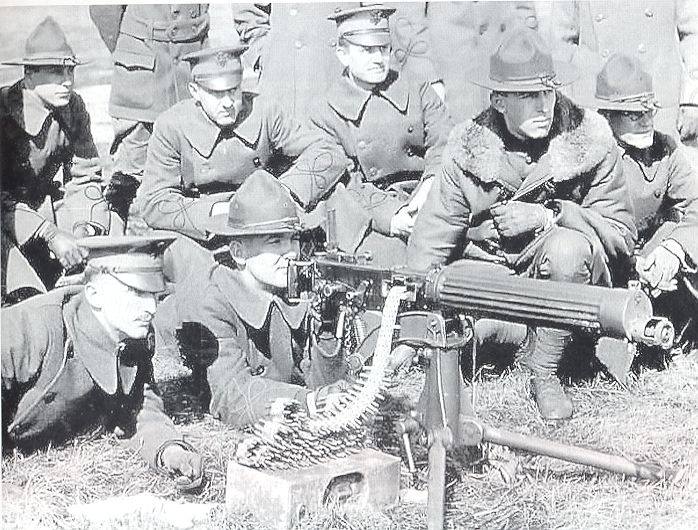
US Army personnel with Model 1915 Vickers (Springfield Armory photo)
When the U.S. entered World War I in April, 1917, not a single Colt Vickers M1915 had been delivered. Needless to say when the United States entered WWI, the US Armed Forces had a substantial lack of machine guns for both training and combat. The below image shows a U.S. WWI machine gun unit training with dummy Vickers guns.
Click on the image to see the detail of the dummy gun.
According to Dolf Goldsmith, each US division in WWI had a total of 192 guns but because the US entered WWI with such a hideously inadequate number of machine guns, the US Army was forced to depend on the British and French for weapons. Specifically, two US National Guard divisions, the 27th and the 30th divisions, were equipped with.303 caliber rifles and machine guns. Here the British supplied the US Army with 231 .303 Vickers guns in 1917 and 1918. The remaining guns were supplied by the British Army in the field. Another twelve US divisions arriving in Europe in late 1917 and early 1918 were assigned to the French Sector. These US units were equipped with 1,334 French heavy Hotchkiss guns, in caliber 8mm Lebel. Ten US divisions, which sailed during May and June of 1918, were armed with US-made M1915 Vickers guns. Other US divisions originally supposed to be equipping with Model 1917 Browning machine gun were again issued .30-06 Vickers because the lack of spare parts for Browning guns. By August, 1918, a total of thirteen US divisions were using the Colt Vickers. In October 1918, plans were made to replace all of the Vickers guns in the hands of US troops with Browning Machine Guns where the Vickers guns would be available for conversion for aircraft use. Less than a month later, the war was over.
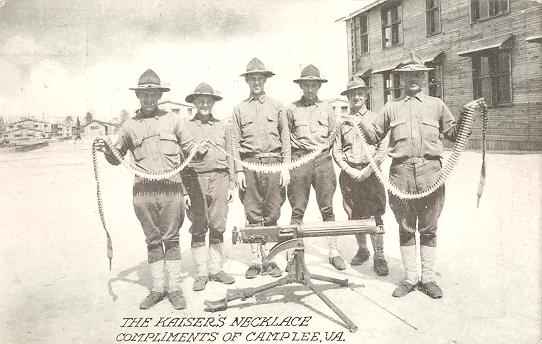
WWI Postcard with US Vickers at Camp Lee, VA
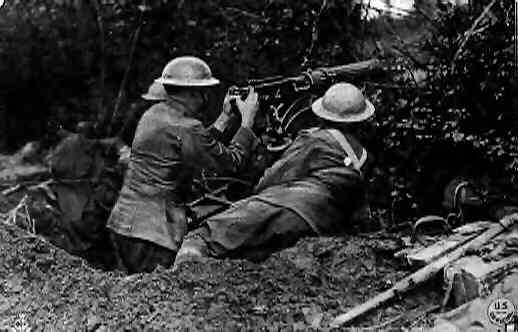
105th MG Bn. gunners with a British Vickers in action at Mazinghein, near St. Souplet
(Source: http://www.angelfire.com/ny5/27thdivision/vickers.html)
As detailed in Small Arms Review (Vol. 7 No. 7, April, 2004) article about the U.S. Vickers, the Vickers was made by the Colt Patent Firearms Manufacturing Company under license from Vickers Sons and Maxim Ltd and was a close copy of its British-made counterpart. In all, 12,125 Vickers Model of 1915 ground guns were produced by Colt. Differentiating the US (Colt) Vickers from the British Vickers has been made even more difficult by the fact that the US gave almost all of the remaining Vickers inventory to England during the lend lease program. After the war they were disbursed to other countries, a majority going to Egypt, and they apparently made little or no attempt to keep the original Colt made-parts together and separate from the Vickers made guns they had also obtained. Some components may have gone to Turkey since I have in my position a Colt Vickers tripod with Turkish modifications.
As mentioned above, American forces were also issued British Vickers. Many Americans would be surprised to learn that the US, Britain, France, and Japan, fought a campaign in Russia just after World War I. The objective was the re-establishment of an Eastern Front following the collapse of the Russian government during the 1917 Bolshevik revolution, but Allied fear of communist ambitions in other countries also played into the intervention. The overall campaign was named the Polar Bear Expedition, but was also known as the Northern Russian Expedition, the American North Russia Expeditionary Force - ANREF or the American Expeditionary Force North Russia - AEFNR. On July 14, 1918, the U.S. Army's 85th Division deployed from Camp Custer, Michigan for France. On July 17, President Wilson agreed to a limited participation by American troops to guard Allied supplies stockpiled in Russia. When U.S. Army General John J. Pershing received the directive from President Wilson, he ordered the 339th Infantry Regiment, the 310th Engineers and other support elements from the 85th Division to Russia. These units were trained and re-outfitted in England with Russian and other non-US arms and then sent to Russia, where they arrived in Arkhangelsk on September 4, 1918 and placed under British command. The below picture shows US soldiers with a British Vickers.
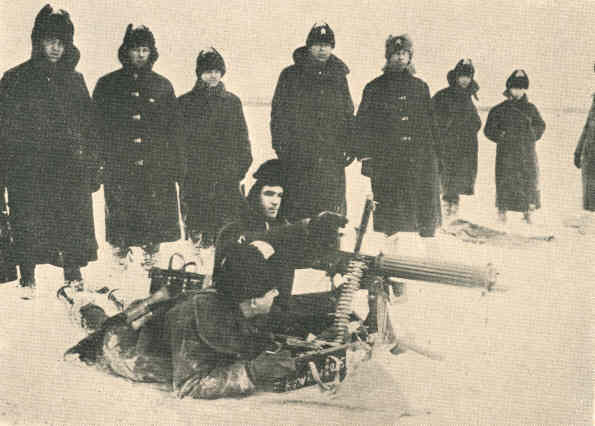
Total Vickers Production
The British Army formally adopted the Vickers gun on 26 November 1912, using it alongside their Maxims. However, as early as in 1911 Vickers Company designed an improved machine gun, which stayed in first-line British service until 30 March 1968. With only minor changes, Vickers machine gun served through WWI to serve again during World War II and the Korean War. There are reports that the Royal Marines kept some Vickers guns in stock as late as 1980s. The Vickers was replaced by the lighter and L7 / FN MAG GPMG. Total Vickers production was:
Nation
|
WWI
|
WWII
|
Total
|
British |
75,242 |
11,828 |
87,070 |
Australia |
12,344 |
12,344 |
|
United States |
19,839
|
19,839
|
|
Japan |
Unknown |
Unknown |
|
Portugal |
|
Unknown |
Unknown
|
Total |
95,081 |
24,172 |
119,253 |
Corrugated Jackets |
~94,253 |
||
Smooth Jackets |
~25,000 |
Another excellent source of information about the Vickers is VickersGun.com. Here you can finds other Vickers photos.

